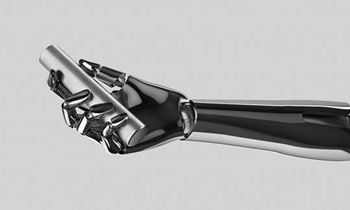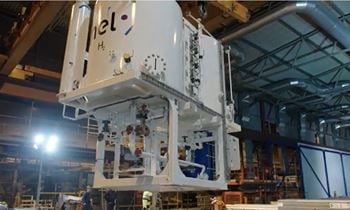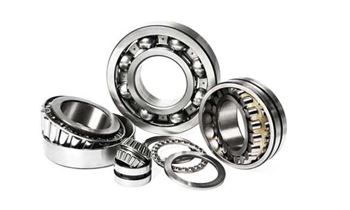Traditionally, steels were classified into four categories: tool steel, stainless steel, engineering steel and maraging steels. That mold was broken in 2017 with the launch of our Hybrid Steel – a new family of grades with an innovative alloying philosophy. The result is that the key properties of each category are available in one high-performance steel.
Tania Loaiza Uribe, Group R&D at Ovako explains that Hybrid Steel get is strength through the combination of two well-established precipitate phases: alloy carbide and inter-metallic. It also uses a creative alloying philosophy that minimizes segregation for consistent performance. The significant levels of aluminum have two benefits: it reacts with nickel to form very small inter-metallic precipitates, but nearer the surface it also helps to form a protective oxide barrier.
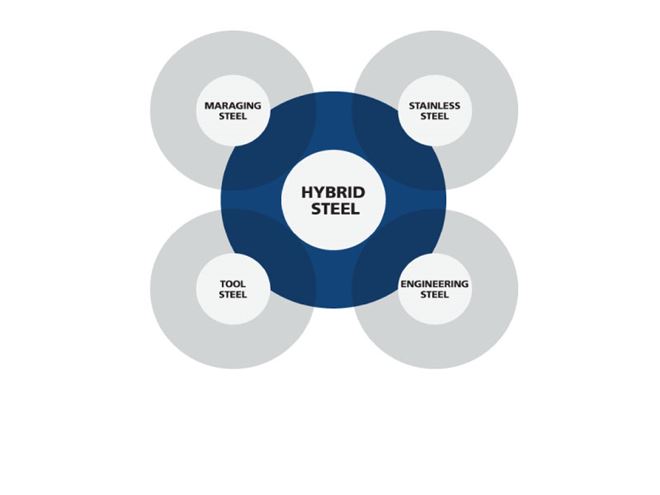
The properties possesed by Hybrid Steel cover all the categories of modern steel.
Hybrid Steel is ideal to meet the demands of high-stress, elevated-temperature applications where mechanical and fatigue strength are critical. It also offers:
- good resistance against corrosion and oxidation
- low distortion after heat treatment
- excellent surface treatment possibilities
- good weldability
- hydrogen resistance
There are currently three Hybrid Steel grades available as their names are based on the hardness they are designed to achieve: 60, 55 and 50 HRC respectively. Hybrid Steel 60 is a unique grade of bearing steel for applications where added strength is needed. Hybrid Steel 55 suits an array of engineering steel needs. Hybrid Steel 50, featuring a lower level of vanadium, is ideal for near-net-shape forging as it does not need to be quenched to achieve a martensitic structure after hot forging.
Hybrid Steel for strength
The strength of Hybrid Steel at elevated temperatures enables it to outperform many conventional steels in demanding applications.
Hybrid Steel for weldability
Until now, welding of ultra-high-strength steels has been virtually impossible due to the high carbon content, which increases cracking sensitivity in as-welded conditions. The low carbon content in Hybrid Steel makes the welding of ultra-high-strength tubes and bars possible for the first time.
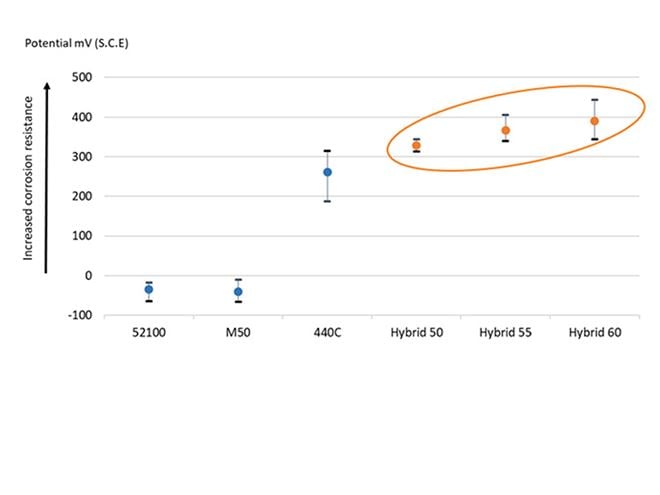
Preliminary ranking of Hybrid Steel for corrosion resistance according to ISO 15158 Corrosion of metals and alloys (modified) 10mV/min 0.01M NaCl (Sodium chloride).
Hybrid Steel for corrosion resistance
The aluminum content of Hybrid Steel enables it to develop a passive layer that offers corrosion resistance comparable to some stainless steels. Figure 5 shows the preliminary ranking of various steels on the corrosion resistance test according to ISO15158. The test pieces are immersed in 0.01M NaCl and the voltage increased until a current of 100 uA/cm2 is reached. The higher the voltage, the better the corrosion resistance. Compared to standard engineering steel (bearing steel), Hybrid Steel shows much better corrosion resistance and even slightly better than AISI 440C.
In the same test, it was also established that a passive layer was formed on the Hybrid Steel, while no noticeable passive region was observed on bearing steel (52100) and 440C steel.
Hybrid Steel for hydrogen resistance
The absorption of atomic hydrogen into bearing steels from the decomposition of lubricants, corrosion, electrical stray current or contaminants such as water promotes premature bearing failure. This is typically indicated by the formation of white etching crack (WEC) underneath the raceway. It is reported in bearings used in wind turbine gearboxes, automotive, paper mill and marine applications.
The hydrogen-trapping capacity of Hybrid Steel 60 compared to 52100 bearing steel. An alloy that is capable of trapping infused hydrogen and rendering it harmless is one approach for preventing hydrogen embrittlement in high strength steel. Hybrid Steel 60 can trap 500 times more hydrogen than 52100. Due to the high hydrogen-trapping capacity and high alloying content, the diffusivity of hydrogen in Hybrid Steel 60 is also expected to be slower.
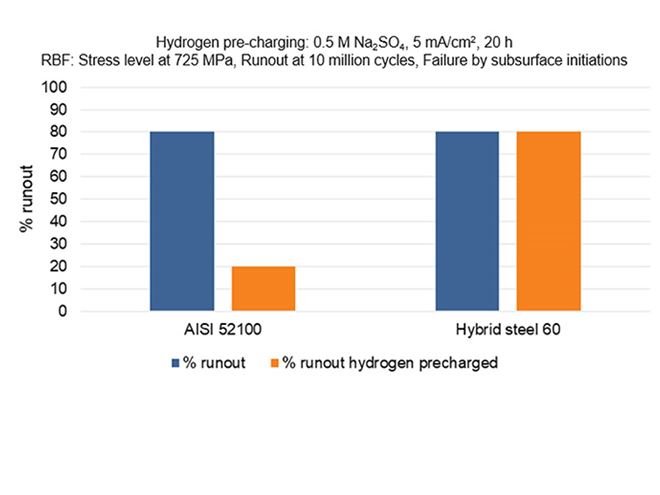
Hydrogen precharged rotating bending fatigue testing of Hybrid Steel 60.
Both increases in hydrogen-trapping capacity and slow hydrogen diffusivity improve the hydrogen resistance during the service life of critical components.
The effect of hydrogen on the rotating bending fatigue life as measured in the number of cycles before failure for 52100 and Hybrid Steel 60. The fatigue life of the hybrid steel is less sensitive to hydrogen.
Hybrid Steel for nitriding
Surface nitriding is one of the most popular methods to prolong the life of parts. It is mainly used to increase the surface hardness and improve wear, fatigue, and tribological performance.
The composition of Hybrid Steel with the addition of 5 % Cr and 2 % Al makes it suitable for nitriding. Since the steel is highly thermal resistant, a high core hardness can be maintained after nitriding. This means that a shallower case depth can be accepted, compared to nitriding of standard engineering steel. Nitriding of Hybrid Steel can be performed at the same temperature as the tempering (500°C–600°C), so it can be carried out in a single step.
The hardness and residual stress after plasma-nitriding of Hybrid 55 at 520°C for 20 hours. It shows that nitriding can be applied to Hybrid Steel at high temperatures while still maintaining a high core hardness.
Hybrid Steel 60 for bearings
Doctoral research at KTH and Ovako has focused specifically on rolling contact fatigue (RCF) in bearing steel. The research is aimed at understanding the stability of the microstructure and its relationship with heat treatments and chemical composition. It has been found that Hybrid Steel 60 exhibits superior microstructural stability compared to 52100 steel. This enhanced stability is attributed to its exceptional resistance to the dissolution of carbide and NiAl under fatigue loading conditions.
A key element in the research has been to establish if using Hybrid Steel can prevent material decay or reduce microstructural damage.
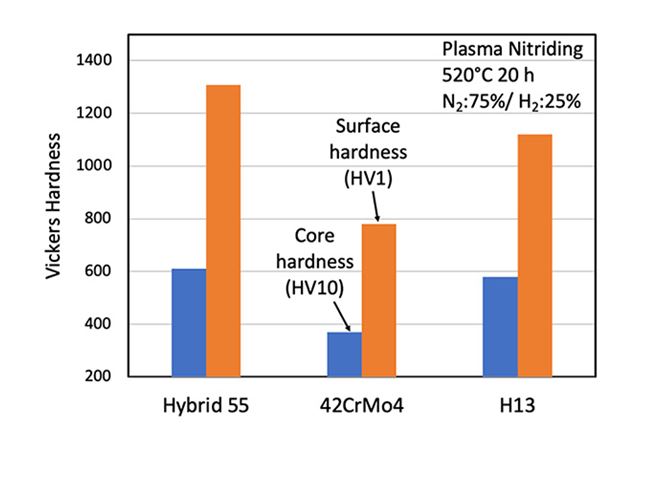
Hybrid Steel makes it possible to carry out nitriding at high temperatures while maintaining a high core hardness.
Hybrid Steel for – the future
Hybrid Steel is proving to be one of the most significant developments in the steel industry for many decades. It is expected to find a wide variety of uses in highly demanding applications such as engine components, bearings, fuel injection components, mining tools and machining tools.
Hybrid Steel could be a key element in future weight and energy-saving initiatives across the engineering sector. The full scope of its potential is only just starting to be explored and we look forward to working with customers to develop the exciting opportunities offered by Hybrid Steel:
- Strength of Hybrid steel
- Weldability
- Corrosion resistance
- Elevated temperature properties
- Fatigue resistance
- Hydrogen embrittlement resistance
